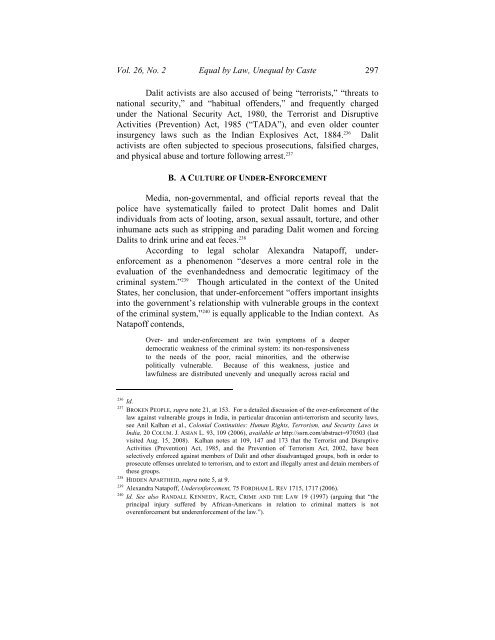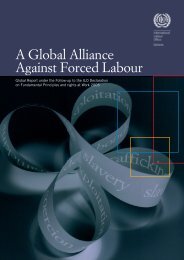equal by law, unequal by caste - International Dalit Solidarity Network
equal by law, unequal by caste - International Dalit Solidarity Network
equal by law, unequal by caste - International Dalit Solidarity Network
You also want an ePaper? Increase the reach of your titles
YUMPU automatically turns print PDFs into web optimized ePapers that Google loves.
Vol. 26, No. 2 Equal <strong>by</strong> Law, Un<strong>equal</strong> <strong>by</strong> Caste 297<strong>Dalit</strong> activists are also accused of being “terrorists,” “threats tonational security,” and “habitual offenders,” and frequently chargedunder the National Security Act, 1980, the Terrorist and DisruptiveActivities (Prevention) Act, 1985 (“TADA”), and even older counterinsurgency <strong>law</strong>s such as the Indian Explosives Act, 1884. 236 <strong>Dalit</strong>activists are often subjected to specious prosecutions, falsified charges,and physical abuse and torture following arrest. 237B. A CULTURE OF UNDER-ENFORCEMENTMedia, non-governmental, and official reports reveal that thepolice have systematically failed to protect <strong>Dalit</strong> homes and <strong>Dalit</strong>individuals from acts of looting, arson, sexual assault, torture, and otherinhumane acts such as stripping and parading <strong>Dalit</strong> women and forcing<strong>Dalit</strong>s to drink urine and eat feces. 238According to legal scholar Alexandra Natapoff, underenforcementas a phenomenon “deserves a more central role in theevaluation of the evenhandedness and democratic legitimacy of thecriminal system.” 239 Though articulated in the context of the UnitedStates, her conclusion, that under-enforcement “offers important insightsinto the government’s relationship with vulnerable groups in the contextof the criminal system,” 240 is <strong>equal</strong>ly applicable to the Indian context. AsNatapoff contends,Over- and under-enforcement are twin symptoms of a deeperdemocratic weakness of the criminal system: its non-responsivenessto the needs of the poor, racial minorities, and the otherwisepolitically vulnerable. Because of this weakness, justice and<strong>law</strong>fulness are distributed unevenly and un<strong>equal</strong>ly across racial and236 Id.237 BROKEN PEOPLE, supra note 21, at 153. For a detailed discussion of the over-enforcement of the<strong>law</strong> against vulnerable groups in India, in particular draconian anti-terrorism and security <strong>law</strong>s,see Anil Kalhan et al., Colonial Continuities: Human Rights, Terrorism, and Security Laws inIndia, 20 COLUM. J. ASIAN L. 93, 109 (2006), available at http://ssrn.com/abstract=970503 (lastvisited Aug. 15, 2008). Kalhan notes at 109, 147 and 173 that the Terrorist and DisruptiveActivities (Prevention) Act, 1985, and the Prevention of Terrorism Act, 2002, have beenselectively enforced against members of <strong>Dalit</strong> and other disadvantaged groups, both in order toprosecute offenses unrelated to terrorism, and to extort and illegally arrest and detain members ofthese groups.238 HIDDEN APARTHEID, supra note 5, at 9.239 Alexandra Natapoff, Underenforcement, 75 FORDHAM L. REV 1715, 1717 (2006).240 Id. See also RANDALL KENNEDY, RACE, CRIME AND THE LAW 19 (1997) (arguing that “theprincipal injury suffered <strong>by</strong> African-Americans in relation to criminal matters is notoverenforcement but underenforcement of the <strong>law</strong>.”).
















